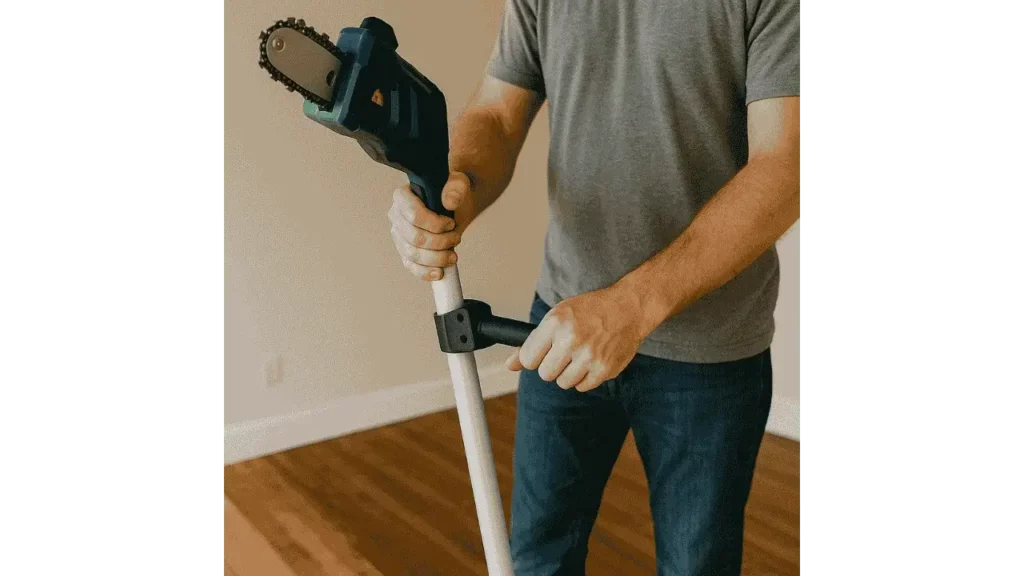Every time I’ve been on a trimming job, there’s always that one branch just out of reach. Pole saws are built for convenience and safety, but sometimes their standard reach isn’t enough. Many models come with built-in extension features or optional attachments. If you’re unsure how to safely get the extra length without compromising control or damaging your tool, you’re not alone. Extending a pole saw the right way can help you trim smarter, not harder.

Know Your Pole Saw Before You Extend It
Types That Can (and Can’t) Extend
Not every pole saw is built for extension. Fixed-length models are set as-is and shouldn’t be forced to stretch. Telescopic pole saws have sliding shafts that lock into place at various lengths, while modular pole saws use add-on segments for extra height. Knowing which type you own is step one.
Power type matters too. Manual saws are light and easy to extend. Battery or electric models often include wiring that limits how far they can be safely lengthened. Gas-powered saws, which are heavier and more powerful, sometimes include specific extension attachments, but handling them at full length can be tricky.
“Always match your extension method to the saw’s design. Overextending or modifying beyond spec is how accidents happen,” says Tyler Groves, lead technician at ArborPro Tools.
Extending a Telescopic Pole Saw
Slide, Lock, and Test
Start by identifying your saw’s locking mechanism; these are usually twist collars or clamp levers. Hold the pole steady, release the lock, and extend slowly. Stop once you reach the manufacturer’s maximum recommended length. Then relock it and give the shaft a gentle tug to check that it’s secure.
Never go past the printed stop lines or indicators. That’s where the structural integrity starts to break down. A good rule of thumb? If it feels unstable or wobbly, pull back to the last secure setting.
Using a Modular or Multi-Piece Extension Pole Saw
Add the Right Sections Safely
Modular pole saws come with extra shaft pieces that screw or clamp onto each other. Align the connectors carefully, fasten them tightly, and double-check there’s no play in the joint. Even the smallest gap can throw off balance and control.
For electric or battery modular models, ensure all wiring or connectors run smoothly through the added sections. Faulty power delivery through the extended shaft can cause shorts or total tool failure.
“When extending any powered pole saw, make sure your internal wiring or cord connection is locked through each joint—loose wires are a hidden hazard,” warns Claire Dawson, senior product safety advisor at GreenSaw Co.
Safe Use Tips When Fully Extended
Handle the Reach Without Losing Control
Once extended, even a lightweight saw becomes more difficult to manage. Keep your feet planted, hands spread, and body stable. Bring the saw in close when possible to avoid being pulled off balance.
Use a shoulder strap if the tool includes one, it distributes weight and lets your arms focus on precision. Cut small sections at a time instead of going for big branches all at once. It keeps the blade more stable and reduces the risk of binding or kickback.
Don’t Push It: When Not to Extend Further?
Respect the Limits
Stick with manufacturer-approved extensions. DIY hacks like taping broom handles or third-party rods to your saw might sound clever, but they compromise safety and can permanently damage your gear.
If your saw doesn’t reach high enough, you’re better off using a ladder with full safety measures or calling in a tree pro. There’s a point where it’s no longer about the saw but about your safety on the ground.
Final Takeaways
Extending your pole saw the right way means knowing your tool, locking extensions correctly, and respecting its limits. Whether it’s a telescopic model or a modular system, each extension should feel stable and secure before you start cutting. Avoid overreaching both with your body and your gear. Safe reach leads to cleaner cuts and fewer regrets on the job.
- How Many Watts Does a Circular Saw Use and Why Does It Matter? - December 1, 2025
- Can You Cut Acrylic With a Circular Saw Safely and Cleanly? - November 29, 2025
- Which Way Does a Circular Saw Blade Go on Your Saw? - November 28, 2025
